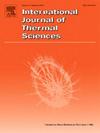基于多输入物理信息神经网络的并联发电机断路器母线温度快速预测
IF 4.9
2区 工程技术
Q1 ENGINEERING, MECHANICAL
International Journal of Thermal Sciences
Pub Date : 2025-07-11
DOI:10.1016/j.ijthermalsci.2025.110142
引用次数: 0
摘要
母线是并联发电机断路器(GCB)中的一个组件,它会经历严重的加热。对母线温度场进行实时监测,不仅保证了并联GCB在正常温度范围内运行,而且间接反映了并联GCB的共流效果。本文首先建立了GCB的电磁-热-流体耦合模型,并与实验结果进行了比较,测点的最大温差为2.0 K,与实验结果非常吻合。其次,采用正交设计与有限元法相结合的方法生成样本。进一步,建立了多输入物理信息神经网络(MIPINNs)模型,将坐标特征(CF)和温度特征(TF)分别输入到深度多层感知器(MLP)和浅层感知器(MLP)中以防止过拟合和欠拟合,并将物理信息损失作为正则化方法纳入网络的损失函数中。与传统的数据驱动模型相比,该方法在有限样本下成功地预测了GCB母线的三维温度场,获得了更好的预测结果。测试集的MAPE和RMSE分别为0.32%和0.29 K,表明误差最小。MIPINNs的预测时间为0.643s,明显快于FEM的4864s。此外,对MIPINNs在极端工况下的预测能力进行了测试,最大温度预测误差为3.7 K,相对误差为2.87%,表明MIPINNs具有较强的泛化能力。此外,使用MIPINNs模型中的温度传感器间接计算接触温度。本文章由计算机程序翻译,如有差异,请以英文原文为准。
Rapid temperature prediction of parallel-connected generator circuit breaker busbar based on multi-input physical information neural network
The busbar is a component in the parallel-connected generator circuit breaker (GCB) that experiences severe heating. Real-time monitoring of the busbar's temperature field not only ensures that the GCB operates within normal temperature limits but also indirectly reflects the current sharing effect of the parallel-connected GCB. In this paper, an electromagnetic-thermal-fluid coupled model of the GCB is first established and compared with experimental results, with a maximum temperature difference of 2.0 K at the measuring points, demonstrating great agreement. Second, samples are generated using orthogonal design combined with finite element method (FEM). Further, A Multi-input Physics-informed Neural Network (MIPINNs) model is established, where the coordinate feature (CF) and temperature feature (TF) are respectively input into a deep multilayer perceptron (MLP) and a shallow MLP to prevent overfitting and underfitting, and physical information loss is incorporated into the network's loss function as a regularization method. This approach successfully predicts the three-dimensional temperature field of the GCB's busbar with limited sample, yielding better prediction results compared to traditional data-driven models. The MAPE and RMSE of test set are 0.32 % and 0.29 K, respectively, indicating minimal error. Moreover, MIPINNs achieves a prediction time of 0.643s, significantly faster than FEM's 4864s. Besides, the prediction capability of MIPINNs under extreme working conditions is tested, the maximum temperature prediction error is 3.7 K, with a relative error of 2.87 %, indicating that MIPINNs possesses strong generalization capability. In addition, the contact temperature is indirectly calculated using temperature sensors in the MIPINNs model.
求助全文
通过发布文献求助,成功后即可免费获取论文全文。
去求助
来源期刊

International Journal of Thermal Sciences
工程技术-工程:机械
CiteScore
8.10
自引率
11.10%
发文量
531
审稿时长
55 days
期刊介绍:
The International Journal of Thermal Sciences is a journal devoted to the publication of fundamental studies on the physics of transfer processes in general, with an emphasis on thermal aspects and also applied research on various processes, energy systems and the environment. Articles are published in English and French, and are subject to peer review.
The fundamental subjects considered within the scope of the journal are:
* Heat and relevant mass transfer at all scales (nano, micro and macro) and in all types of material (heterogeneous, composites, biological,...) and fluid flow
* Forced, natural or mixed convection in reactive or non-reactive media
* Single or multi–phase fluid flow with or without phase change
* Near–and far–field radiative heat transfer
* Combined modes of heat transfer in complex systems (for example, plasmas, biological, geological,...)
* Multiscale modelling
The applied research topics include:
* Heat exchangers, heat pipes, cooling processes
* Transport phenomena taking place in industrial processes (chemical, food and agricultural, metallurgical, space and aeronautical, automobile industries)
* Nano–and micro–technology for energy, space, biosystems and devices
* Heat transport analysis in advanced systems
* Impact of energy–related processes on environment, and emerging energy systems
The study of thermophysical properties of materials and fluids, thermal measurement techniques, inverse methods, and the developments of experimental methods are within the scope of the International Journal of Thermal Sciences which also covers the modelling, and numerical methods applied to thermal transfer.
 求助内容:
求助内容: 应助结果提醒方式:
应助结果提醒方式:


